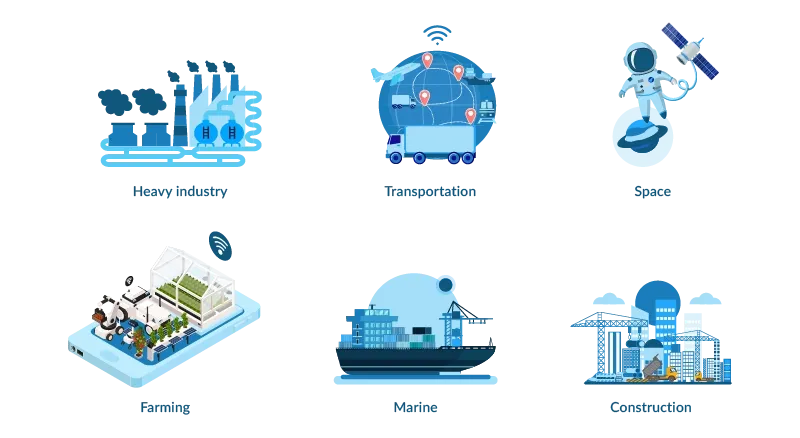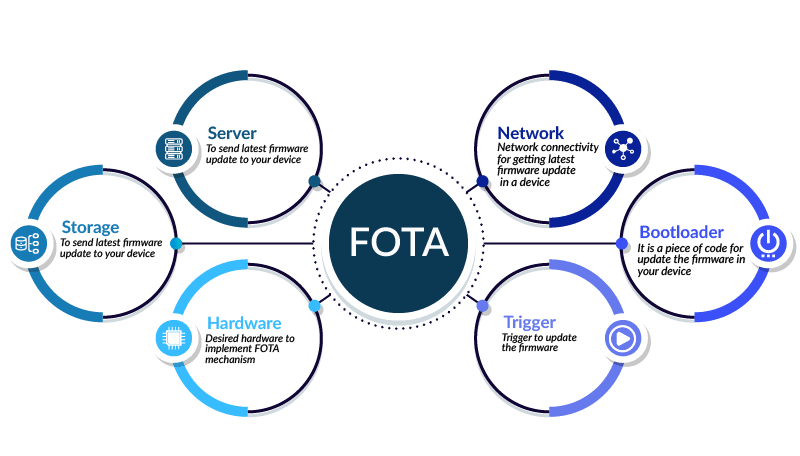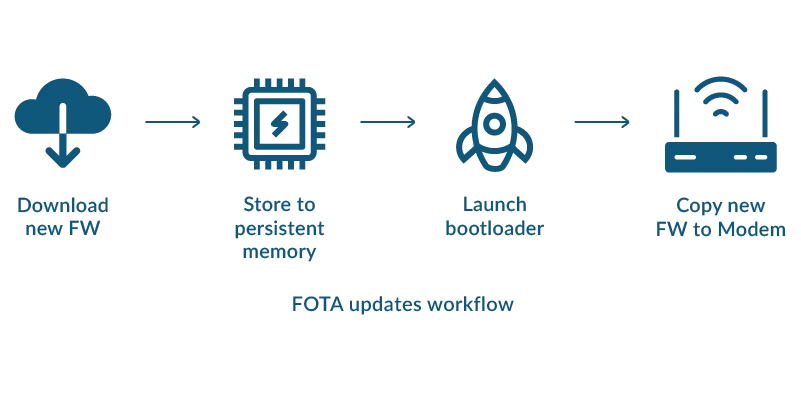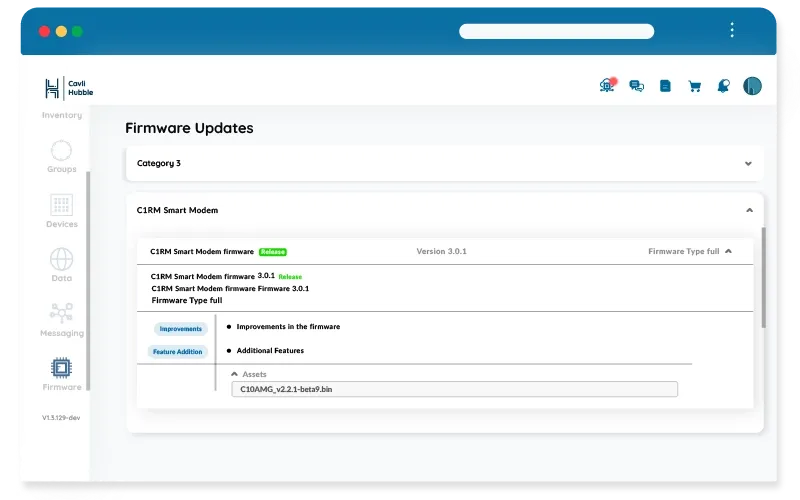What is FOTA?
FOTA, or Firmware Over-The-Air, is a revolutionary technology that allows device makers and network providers to remotely update the firmware of internet-connected devices wirelessly. With FOTA (full form: Firmware Over-The-Air), devices like smart home appliances with IoT Modules and cellular connectivity can get the latest firmware enhancements directly over the air, removing the need for manual, physical updates. This wireless update capability is critical for maintaining device security, rolling out new features, and fixing software bugs.
The FOTA update process significantly reduces downtime and eliminates the hassle of connecting devices to computers for software enhancements, making it more efficient and user-friendly. By enabling seamless wireless updates, FOTA ensures that devices run on the latest software, directly contributing to their longevity and resilience against security threats. This is particularly important in the context of "firmware update," which means ensuring that the embedded software controlling the hardware is consistently improved and patched against vulnerabilities.
For products with IoT modules and cellular connectivity, OTA (Over-The-Air) updates are especially crucial to keep the devices efficient and secure through timely firmware updates. FOTA plays a key role in managing the lifecycle of smart devices, IoT assets, and mobile gadgets, ensuring they run the most up-to-date and secure software versions. This technology is vital for improving user experience, boosting device performance, and protecting against cyber threats.
In recent advancements, FOTA technology has evolved to support incremental updates, which means only the changed parts of the firmware are sent over the air, reducing data usage and speeding up the update process. This makes FOTA updates even more efficient and cost-effective, especially for IoT devices with limited bandwidth. In short, FOTA enables seamless wireless firmware updates, future-proofing internet-connected devices against obsolescence and vulnerability, and making the process of "firmware update" more streamlined than ever before.
Staying Updated - Is that only for Humans?
How do we humans stay updated? One would consider reading a book or catching up with their favorite news channel. Keeping yourself informed is actually a necessity for survival. If we do not have the knowledge, information, and tools necessary to survive, we will surely be left behind. It's just as important for our devices to update from time to time.
If you own a smartphone or a tablet, then you are probably familiar with the way your device checks for updates over the air. Simply put, it does that automatically. While most devices have the ability to update them manually, many times, we don't bother. Our devices are so smart, and they do all the work in the background without us even noticing. Let's take a look at why our firmware updates are so important.
Every device needs an update. As our devices get more sophisticated and complex, it’s important for its operating system and the underlying software layer to be kept up to date. Updates are scheduled at specific times when a device is deemed ready for such upgrades. This could be the developer adding new features, bug fixes, or even improving security. These updates are necessary to ensure the performance of the devices. In the case of IoT devices, it would be nearly impossible to rely on something for updates as devices are used at scale.
Firmware vs Software: Understanding the Difference with FOTA (Firmware Over-The-Air) Updates
Firmware and software are two different components that might seem similar but serve distinct purposes. Firmware is the hardware-specific version of a computer program, whereas software is the broader term that refers to the instructions that tell your device what to do. Essentially, firmware is the code that allows a device to control its hardware and communicate with other systems, managing tasks such as memory access and interfacing with peripheral devices. In contrast, software includes all types of programs, applications, and operating systems that run on your device.
Let’s use the example of Smart TVs to illustrate the difference. Firmware updates for Smart TVs, often executed through a FOTA update (Firmware Over-The-Air), can enhance color profiles, improve efficiency, and add new technical features. FOTA makes it possible to perform these firmware updates wirelessly, without requiring any physical connection, which is a game-changer for modern smart devices. This is what "firmware update means" in a practical context: updating the embedded software that controls hardware functionality.
On the other hand, software updates on a Smart TV might include changes to the user interface, updates to downloaded apps, or new features added to the TV’s operating system. While firmware updates are less frequent, they are crucial for the overall functionality and security of the device. FOTA technology ensures that these firmware updates are efficiently delivered, keeping devices secure and up-to-date.
A FOTA update can also provide critical bug fixes to the operating system of a device or introduce brand-new features, significantly improving performance and extending the device's lifecycle. In contrast, software updates are generally more frequent and revolve around making improvements to applications, patching security flaws, or optimizing performance.
From Firmware to ‘Firmware Over the Air’
Most of you are aware that your car or automobile has an ECU (Electronic Control Unit) on which software or firmware runs. This firmware ensures that the 100 different sub-systems, which constitute the construct of a vehicle – from the steering wheel to the axle, the immobilizer, to the odometer – all function as a single coherent unit. This crucial firmware essentially forms the backbone of the vehicle's operations, ensuring everything runs smoothly.
Have you wondered how updates to the firmware/software of automobiles used to happen in the early 1990s? Here is an article that dives into the topic of FOTA for Automotive specifically. Traditionally, updating the firmware meant that the customer had to either visit a service center or wait for a representative from the car manufacturer to come to their location to perform the update. It was a time-consuming process, often involving manual intervention and technical expertise.
Enter FOTA (Firmware Over-The-Air) technology, which revolutionized this process, especially with FOTA for Automotive applications. With the FOTA feature, a firmware upgrade is now just a click away. The FOTA full form—Firmware Over-The-Air—speaks to this technology’s ability to wirelessly deliver firmware updates to a vehicle, eliminating the need for physical intervention. This makes the process not only convenient but also highly efficient.
By using FOTA updates, car manufacturers can easily send firmware improvements, security patches, and bug fixes straight to your vehicle, all without you having to lift a finger. This means no more trips to the service center or having to pop open the car's hood for an update. It saves time and keeps your car running smoothly with the latest features and security enhancements. This shift is a real game-changer for the automotive world, as these firmware updates help boost your vehicle's performance, safety, and functionality – all while you continue driving, without any interruptions to your daily routine.
The Importance of FOTA in IoT
FOTA (Firmware Over-The-Air) has revolutionized the way we manage and secure the rapidly growing network of connected IoT devices worldwide. With billions of IoT assets in operation, manually updating each device's firmware is both impractical and unfeasible. FOTA provides a seamless, wireless solution that enables efficient firmware updates, ensuring devices remain secure, functional, and up-to-date.
Enhanced Security:
FOTA allows for the quick deployment of security patches, safeguarding IoT devices against emerging cyber threats and vulnerabilities. This process ensures that each FOTA update contributes to the device's resilience against potential attacks. Given the increasing sophistication of cyber threats, advanced encryption standards are now incorporated into firmware over the air updates to secure the transmission process, preventing any interception or tampering during delivery. This feature is critical as it guarantees that the firmware update means not just adding new features but also enhancing the overall security of the device.
Rapid Bug Fixes:
One of the significant advantages of using FOTA in IoT is the ability to introduce new features and improvements without causing any disruption to the user experience. Regular firmware updates are key to maintaining device performance and reliability. With AI integration, FOTA systems can predict and automate updates based on device performance data and emerging security trends. This level of automation reduces the need for human intervention and ensures that updates are timely and effective.
In essence, FOTA enables efficient, over the air updates for IoT devices, allowing entire fleets to be kept up-to-date, secure, and optimized without the need for manual firmware interventions. These FOTA updates ensure that devices across various locations receive simultaneous enhancements, minimizing downtime and ensuring consistent performance and security standards. As the number of IoT devices continues to multiply exponentially, this wireless and scalable solution is indispensable for managing the lifecycle of connected devices efficiently and effectively.
The Security Benefits of FOTA for IoT Devices
FOTA (Firmware Over-The-Air) updates provide critical security enhancements for IoT devices:
Rapid Patching:
FOTA allows security patches to be deployed instantly, fixing vulnerabilities in real-time to protect against cyber threats. These firmware updates are crucial for maintaining robust security measures.
Uniform Protection:
FOTA updates standardize security across all devices, no matter where they are located physically. Through OTA updates, every device receives the same security enhancements simultaneously, ensuring a uniform defense layer.
Automation Reduces Risk:
By automating updates through FOTA, it minimizes human error that could introduce vulnerabilities. Automated firmware updates through FOTA significantly lower the chances of oversight or delay in applying critical patches.
Future-Proofing:
FOTA updates make devices adaptable to new threats, ensuring long-term defense against evolving cyber risks. The continuous delivery of OTA updates helps to keep the IoT devices prepared for future threats by constantly updating their firmware.
FOTA provides a robust method for reinforcing IoT devices against emerging security threats by deploying firmware updates automatically and wirelessly. This capability ensures that vulnerabilities can be swiftly and efficiently mitigated across widespread device fleets through over the air updates. Essential for safeguarding the rapidly increasing count of connected IoT devices, FOTA plays a pivotal role by routinely delivering OTA updates that both enhance security measures and improve device performance. These firmware updates are critical for maintaining optimal functionality and securing devices from potential threats.
Implementing Secure FOTA Objects in IoT
The implementation of Secure FOTA Objects involves several best practices to maximize their effectiveness in enhancing device security:
End-to-End Encryption:
Updates should be encrypted from the point of dispatch to the point of installation, safeguarding against unauthorized interception and alteration.
Uniform Protection:
FOTA updates standardize security across all devices, no matter where they are located physically.
Verification Mechanisms:
Utilizing digital signatures or checksums ensures the authenticity and integrity of firmware updates, confirming they haven't been tampered with.
Robust Recovery Strategies:
In case of update failure, mechanisms should be in place to revert devices to a secure, operational state, preventing potential service disruptions.
Engaging Users Securely:
Informing users about upcoming updates and obtaining consent when necessary is crucial for maintaining transparency and ensuring user trust in the IoT ecosystem.
What devices need FOTA capability?
FOTA becomes a necessity where devices or machines are expected to function in harsh and uncontrolled environments where human intervention is minimal to nothing at all. Commonly known industries characterized by harsh environments are transportation, marine, space, construction, heavy industry, and farming.

Benefits of FOTA
- In scenarios where human/on-field intervention is not possible, FOTA offers room for scalability through regular updates to meet the changing trends and customer expectations.
- Helps cut down on customer care and minimize operational costs.
- Testing is made easy as updates can be released in phases for testing before rolling out to all devices.
Securing Devices with Advanced FOTA Protocols
Firmware Over-The-Air (FOTA) technology transcends mere convenience; it acts as a robust fortress of security protocols, safeguarding your devices against evolving cyber threats. Through the implementation of advanced measures such as end-to-end encryption, meticulous digital signature verification, and resilient recovery strategies, FOTA updates are fortified to prevent unauthorized access and potential vulnerabilities. Our unwavering commitment to cutting-edge security ensures that each update not only enhances your device's defenses but also provides unparalleled peace of mind in an interconnected world where cybersecurity is paramount.
Versatile FOTA Applications: From Automotive to Healthcare
The adaptability and versatility of FOTA technology extend across industry boundaries, empowering diverse sectors with timely firmware updates and enhanced functionalities. Envision critical OTA updates seamlessly deployed to medical devices during health crises, ensuring optimal performance and patient safety. Similarly, precision adjustments made to agricultural equipment in response to changing environmental conditions exemplify FOTA's cross-industry impact. This versatility underscores FOTA's role as a transformative technology driving innovation and efficiency across various sectors, from automotive to healthcare to agriculture. The ability to deliver over the air updates not only streamlines the update process but also significantly reduces downtime and resource allocation for manual firmware updates, showcasing FOTA's potential to enhance operational continuity and safety in critical industries.
Real-World Benefits of FOTA for Users
Firmware Over-The-Air (FOTA) updates bring a myriad of tangible benefits to end users, enhancing the overall user experience and maximizing the value of their devices. These firmware updates play a crucial role in enhancing device performance across different categories, optimizing system resources, improving app responsiveness, and streamlining overall functionality. Users often notice significant improvements in app launch times, multitasking capabilities, and system stability after receiving FOTA updates. Additionally, FOTA extends device longevity by delivering software optimizations, bug fixes, and performance enhancements over time, allowing users to delay the need for frequent device upgrades and maximizing their return on investment in technology.
Moreover, OTA updates introduce new features and functionalities to devices, enriching the user experience and adding value to the product. These new features range from improved camera capabilities and advanced security measures to enhanced connectivity options and innovative user interface enhancements. Users benefit from access to these features without the hassle of purchasing new hardware or devices, making FOTA updates a cost-effective way to stay updated with the latest technology trends while enjoying a seamless and optimized digital experience tailored to their evolving needs.
FOTA in Automotive Industry
Firmware Over-The-Air (FOTA) technology is reshaping the automotive industry, fundamentally altering how vehicles receive updates and improvements. With the rapid progression of electrification and the emergence of autonomous vehicles, the need for streamlined software management solutions has never been more critical. FOTA in automotive, also referred to as FOTA in automotive circles, stands out as a prime example of technological innovation in this sector. Unlike traditional methods that often require physical interventions or hardware replacements, FOTA in automotive enables seamless updates to be deployed wirelessly, revolutionizing the way vehicles are managed and enhanced.
Brands have embraced FOTA in automotive with remarkable success, leveraging its capabilities to introduce cutting-edge features and functionalities without the need for extensive hardware modifications. This approach not only saves time and resources but also ensures that vehicles remain up-to-date with the latest software advancements. From enhancing battery efficiency in electric vehicles (EVs) to optimizing driver-assistance systems in connected cars, FOTA in automotive updates play a pivotal role in ensuring that automotive technology remains at the forefront of innovation.
Looking ahead, the integration of artificial intelligence (AI) and predictive analytics into FOTA in automotive holds immense promise. This next phase of development aims to deliver even more personalized updates, tailored to individual user preferences and driving habits. By anticipating user needs and optimizing vehicle performance proactively, FOTA in automotive continues to drive excellence, efficiency, and innovation in the automotive industry.
How does a FOTA update work?

Source: Blocks of FOTA Mechanism
Remember those push notifications that say software update pending? That is a type of FOTA update for mobile phones. A typical FOTA for mobile phones is a direct process that all of us have performed. The developer pushes the software update to the phone. Mobile applications are updated from the AppStore or Playstore, whereas other devices connected to the internet are updated directly from the settings panel.

For other IoT devices, there are various types of architecture available. The right architecture for that device is dependent on the ‘network layout.’ Broadly, there are three different OTA architectures — Edge-to-cloud, gateway-to-cloud, and edge-to-gateway-to-cloud.
- Edge-to-cloud updates (E2C): A connected device receives FOTA packages from a remote server. It is one of the common architectures used for geographically distributed devices. An IIoT device can receive updates directly from the cloud in this architecture.
E.g. Google Home, Apple Siri and the Nest thermostat are a few instances of the E2C update method. - Gateway-to-Cloud updates (G2C): A system with an Internet-connected gateway that controls a set of local devices gets updates from a remote cloud-based server (for example, a telematics system). In this case, the connected devices are not updated but rather the gateway itself.
E.g. ATMs, remote energy monitoring systems, and other banking and financial services like kiosks are examples of devices that use G2C OTA update methods. - Edge-to-Gateway-to-Cloud OTA updates (E2G2C): The edge gateway acts as a dispatcher that downloads IoT updates from the cloud-based server and then transmits them to another edge/gateway or IoT device. In this case, the IoT devices should be able to execute the update by themselves.
E.g. This method is used by devices such as field-based sensors such as temperature, humidity sensors, weather sensors and other industrial management sensor systems.
FOTA for LPWAN IoT
Conventionally, a FOTA update requires high speed and extra power. To understand better, our mobile devices always recommend a wi-fi connection, certain system storage availability, and a 50% battery or power connection at the time of device update. This is to ensure the device is able to install the update without any glitches.
However, the majority of industrial solutions that are now getting 'Smart-Connected' are leveraging the Low Power Wide Area Network (LPWAN) based networks for connectivity, long-range coverage, and efficient energy usage. Low-power WAN (LPWAN) helps low-bandwidth, battery-powered devices connect with low bit rates over long ranges.
To ensure successful FOTA updates for IIoT devices across use cases like agri-produce management, worksite monitoring, fleet management, or smart city applications, developers need to consider LPWAN-optimized incremental FOTA. An incremental FOTA update is typically smaller and only includes encoding the differences between the two files. Incremental FOTA allows developers to update parts of code instead of the need to overwrite the entire firmware package. This helps save on time and cost.
Here’s a basic flow diagram on how Firmware is downloaded and updated on a device.

How Cavli enables Firmware-Over-The-Air (FOTA) updates to deployed devices
Introducing the world’s first truly enterprise-grade IoT connectivity management cloud platform Cavli Hubble from Cavli Wireless, where you can securely manage & control all your connected devices, data subscriptions, over-the-air updates, and remote diagnostics. Get onboarded on Cavli Hubble to supercharge your IoT enablement journey like never before.

A successful FOTA update requires complex coordination between IoT hardware, device firmware, network connectivity, and the IoT device cloud. This usually means having your own device cloud and firmware update stack, which would require further R&D and architecture.
Cavli mitigates this issue with Cavli’s C Series - Smart Cellular IoT Modules, which have FOTA stack enabled, providing your deployed Smart Modules updates that bring in new features and crucial improvements in Security which allows your devices to be in use for years ahead.
Feel free to write to us at solutions@cavliwireless.com, or you can book a demo directly with the link below.


